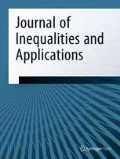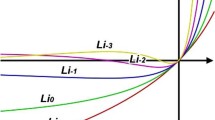Abstract
A new Kantorovich type inequality for Hermite matrices is proposed in this paper. It holds for the invertible Hermite matrices and provides refinements of the classical results. Elementary methods suffice to prove the inequality.
Similar content being viewed by others
1. Introduction
We first state the well-known Kantorovich inequality for a positive definite Hermite matrix (see [1, 2]), let  be a positive definite Hermite matrix with real eigenvalues
be a positive definite Hermite matrix with real eigenvalues  . Then
. Then

for any  ,
,  , where
, where  denotes the conjugate transpose of the matrix
denotes the conjugate transpose of the matrix  . An equivalent form of this result is incorporated in
. An equivalent form of this result is incorporated in

for any  ,
,  .
.
This famous inequality plays an important role in statistics and numerical analysis, for example, in discussions of converging rates and error bounds of solving systems of equations (see [2–4]). Motivated by interests in applied mathematics outlined above, we establish in this paper a new Kantorovich type inequality, the classical Kantorovich inequality is modified to apply not only to positive definite but also to all invertible Hermitian matrices. An elementary proof of this result is also presented.
In the next section, we will state the main theorem and its proof. Before starting, we quickly review some basic definitions and notations. Let  be an invertible Hermite matrix with real eigenvalues
be an invertible Hermite matrix with real eigenvalues  , and the corresponding orthonormal eigenvectors
, and the corresponding orthonormal eigenvectors  with
with  , where
, where  denotes 2-norm of the vector of
denotes 2-norm of the vector of  .
.
For  , we define the following transform
, we define the following transform

If  , then,
, then,

Otherwise,  , then,
, then,

where

2. New Kantorovich Inequality for Hermite Matrices
Theorem 2.1.
Let  be an
be an  invertible Hermite matrix with real eigenvalues
invertible Hermite matrix with real eigenvalues  . Then
. Then

for any  ,
,  , where
, where  ,
,  ,
,  ,
,  defined by (1.3), (1.4), (1.5), and (1.6).
defined by (1.3), (1.4), (1.5), and (1.6).
To simplify the proof, we first introduce some lemmas.
Lemma 2.2.
With the assumptions in Theorem 2.1, then

for any  ,
,  .
.
Lemma 2.3.
With the assumptions in Theorem 2.1, then

for any  ,
,  .
.
Proof.
Let  , then
, then

while

The proof about  is similar.
is similar.
Lemma 2.4.
With the assumptions in Theorem 2.1, then

for any  ,
,  .
.
Proof.
Thus,

The other inequality can be obtained similarly, the proof is completed.
We are now ready to prove the theorem.
Proof.
Thus,

while

By the Lemma 2.4, we have

Similarly, we can get that,

Therefore,

From  for real numbers
for real numbers  , we have
, we have

The proof of Theorem 2.1 is completed.
Remark 2.5.
Let  be a positive definite Hermite matrix. From Theorem 2.1, we have
be a positive definite Hermite matrix. From Theorem 2.1, we have

our result improves the Kantorovich inequality (1.2), so we conclude that Theorem 2.1 gives an improvement of the Kantorovich inequality that applies all invertible Hermite matrices.
Example 2.6.
Let

The eigenvalues of  are:
are:  ,
,  ,
, by easily calculating, we have
by easily calculating, we have

Therefore,

we get a sharpen upper bound.
3. Conclusion
In this paper, we introduce a new Kantorovich type inequality for the invertible Hermite matrices. In Theorem 2.1, if  ,
,  , the result is well-known Kantorovich inequality. Moreover, it holds for negative definite Hermite matrices, even for any invertible Hermite matrix, there exists a similar inequality.
, the result is well-known Kantorovich inequality. Moreover, it holds for negative definite Hermite matrices, even for any invertible Hermite matrix, there exists a similar inequality.
References
Horn RA, Johnson CR: Matrix Analysis. Cambridge University Press, Cambridge, UK; 1985:xiii+561.
Householder AS: The Theory of Matrices in Numerical Analysis. Blaisdell, New York, NY, USA; 1964:xi+257.
Wang S-G: A matrix version of the Wielandt inequality and its applications to statistics. Linear Algebra and its Applications 1999,296(1–3):171–181.
Nocedal J: Theory of algorithms for unconstrained optimization. Acta Numerica 1992, 1: 199–242.
Acknowledgments
The authors would like to thank the two anonymous referees for their valuable comments which have been implemented in this revised version. This work is supported by Natural Science Foundation of Jiangxi, China No 2007GZS1760 and scienctific and technological project of Jiangxi education office, China No GJJ08432.
Author information
Authors and Affiliations
Corresponding author
Rights and permissions
Open Access This article is distributed under the terms of the Creative Commons Attribution 2.0 International License (https://creativecommons.org/licenses/by/2.0), which permits unrestricted use, distribution, and reproduction in any medium, provided the original work is properly cited.
About this article
Cite this article
Liu, Z., Wang, K. & Xu, C. A Note on Kantorovich Inequality for Hermite Matrices. J Inequal Appl 2011, 245767 (2011). https://doi.org/10.1155/2011/245767
Received:
Accepted:
Published:
DOI: https://doi.org/10.1155/2011/245767




